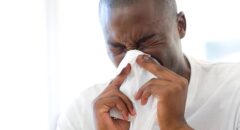
Mold. It grows on bathroom walls, it makes basements smell bad, and it ruins perfectly good loaves of bread. And if you have a mold allergy, there’s a good chance that it will add to your misery.
The spores from common molds function much like the pollen from ragweed. If you inhale the spores, you could get a case of allergic rhinitis, otherwise known as hay fever — an unpleasant combination of runny nose, sneezing, watery eyes, itching, congestion and coughing. And if you have asthma, the spores may trigger attacks. More than 80 types of mold have been associated with lung, nose, and throat problems, according to the American College of Allergy, Asthma, and Immunology (ACAAI). It’s possible that mold may even lead to the development of asthma.
Fortunately, only about 25 percent of people with allergies are allergic to mold, according to the American College of Occupational and Environmental Medicine (ACOEM). The organization estimates that 10 percent of Americans are allergic to mold, and for about half of them, the allergy may result in an actual illness. The good news is that you can reduce your exposure to mold with a few simple steps.
RELATED: What Happens When Your Lungs Are Exposed To Mold?
What is mold, and where does it grow?
Mold is a type of fungus, a diverse kingdom that also includes mushrooms and yeasts. Unlike plants, molds and other fungi feed on organic material, whether it’s a rotting tree or a carpet in your basement, by breaking them down and absorbing their nutrients.
Mold thrives in warm, moist environments. The air can be full of it in the warm summer months, often causing seasonal cases of hay fever. In the South, where it’s warm and humid enough for mold to live all year long, allergies to outdoor molds can be a constant nuisance.
Molds can live indoors, too. They’ve even been found in subfreezing temperatures: The only thing they need is oxygen, something to feed on, and moisture. A damp basement is the classic hot spot. Mold can also thrive on carpets in other moist places, such as basements, closets, and bathrooms. Other potential moldy places include tubs, shower stalls, air conditioners, humidifiers, garbage cans, mattresses, and upholstered furniture.
How do you know if you have a mold allergy?
Your doctor can give you a test to see if you’re sensitive to mold, but the test isn’t exactly foolproof. For one thing, doctors don’t have samples for every common type of mold. (Molds can be surprisingly hard to grow in a lab). In most cases, however, you can find out with reasonable certainty if you have anything to fear from mold.
A mold allergy causes the same signs and symptoms that occur in other types of upper respiratory allergies, according to the Mayo Clinic. Signs and symptoms of allergic rhinitis caused by a mold allergy can include:
- Sneezing
- Runny or stuffy nose
- Cough and postnasal drip
- Itchy eyes, nose and throat
- Watery eyes
- Dry, scaly skin
Some people might have year-round symptoms while others may have symptoms that flare up only during certain times of the year, such as when the weather is damp or when you’re in indoor or outdoor spaces that have high concentrations of mold.
In some people, exposure to certain molds can cause a severe asthma attack with the following symptoms:
- Coughing
- Wheezing
- Shortness of breath
- Chest tightness
How are mold allergies treated?
The best treatment for mold allergies is avoiding mold in the first place. But if you live in a place where mold is unavoidable, your doctor can offer additional help. You may need an antihistamine medication to control your symptoms. In severe cases, your doctor may prescribe a








